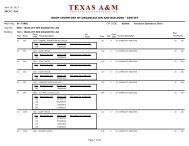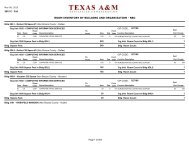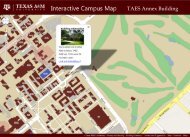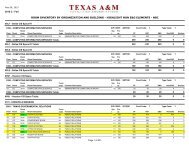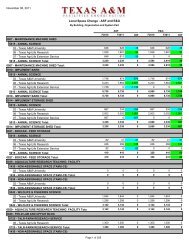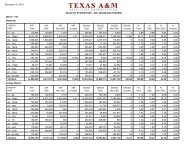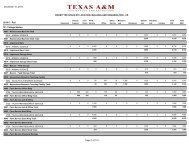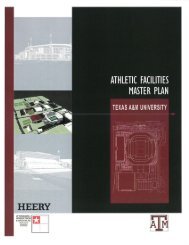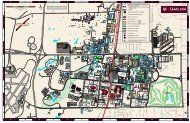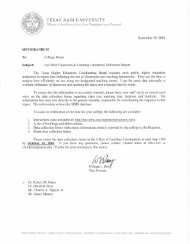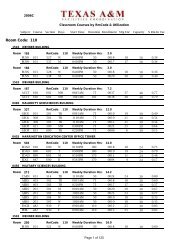Space Utilization - Office of Facilities Coordination
Space Utilization - Office of Facilities Coordination
Space Utilization - Office of Facilities Coordination
You also want an ePaper? Increase the reach of your titles
YUMPU automatically turns print PDFs into web optimized ePapers that Google loves.
<strong>Space</strong> <strong>Utilization</strong><br />
Not just for classrooms anymore<br />
Annie Newman<br />
Bob Boes<br />
1
Who’s heard this?<br />
Campus research space is significantly overcrowded.<br />
I’m sure that is hoarding space.<br />
We just build two buildings; how can we be out <strong>of</strong> space?<br />
We can solve this if we tighten space standards.<br />
Why can’t we use old warehouse for the neuroscience grant?<br />
2
The strategic view<br />
Identify your institution’s strategic business goals, e.g.<br />
Enrollment<br />
Research direction<br />
Strategic academic plans<br />
Capital project strategy<br />
Relate space analysis specifically to those goals<br />
Where do you have leverage to further those goals?<br />
Labs<br />
<strong>Office</strong>s<br />
Introduction<br />
3
What can you really work with?<br />
Introduction<br />
4
Leverage<br />
Data taken from a study <strong>of</strong> 76 Colleges and<br />
Universities with enrollments less than 6,000 students<br />
Data taken from a benchmark <strong>of</strong> 13 doctoral/research<br />
institutions ranging from 3.4M – 12M GSF<br />
Introduction<br />
5
Narrow the focus further<br />
Some lab space is relatively untouchable…<br />
Teaching Labs<br />
Research Labs<br />
Open Labs<br />
Highly specialized spaces (e.g. clean rooms, FMRI suites)<br />
Undergraduate vs. Graduate<br />
<strong>Office</strong>s<br />
Physical Reality vs. Guidelines<br />
Introduction<br />
6
What do you need to really manage your space?<br />
Accurate, complete, consistent data<br />
<strong>Utilization</strong> metrics<br />
Continuous space analysis<br />
Supportive space policies<br />
Integrated space, academic, & capital planning<br />
Assess Current Situation<br />
7
Assess Current Situation<br />
8
Building a space inventory<br />
Analyze best sources <strong>of</strong> information<br />
(finance, HR, IT, security, plant<br />
operations...)<br />
Assignable space first – consider residential life and athletics last<br />
Create a plan that produces results and build on it over time<br />
Partner with departments that have money to spend<br />
It’s not rocket science – start with simple spreadsheets<br />
and move to CAFM when the time is right<br />
Determine the best group to own and maintain<br />
the data and drawings<br />
Assess Current Situation<br />
9
<strong>Facilities</strong> Inventory and Classification Manual<br />
(FICM)<br />
US Dept. <strong>of</strong> Education National Center for Education Statistics (NCES)<br />
Basic Principals<br />
Room Type Definitions<br />
Room Use Codes<br />
Function Taxonomy<br />
Area Measurement Standards<br />
Free download from NCES:<br />
http://nces.ed.gov/pubsearch/pubsinfo.asp?pubid=92165<br />
Assess Current Situation<br />
10
Refining room types<br />
:<br />
What have you really got?<br />
FICM definitions can and should be adapted<br />
Consider finer room type definitions or additional<br />
descriptive fields:<br />
<strong>Office</strong>s Faculty:<br />
Tenure track<br />
Visiting<br />
Adjuncts<br />
Emeriti<br />
Senior Administration<br />
Pr<strong>of</strong>essional Staff<br />
Clerical Staff<br />
Technical Staff<br />
Student Employees<br />
Student Organizations<br />
Wet Labs<br />
In Vitro (cells, tissue)<br />
In Vivo (live animals)<br />
Chemical<br />
Dry Labs Computationa<br />
lImaging<br />
Cognitive<br />
Core Labs Shared space,<br />
<strong>of</strong>ten equipment-intensive<br />
Teaching Labs Wet sciences<br />
Dry sciences<br />
Social sciences<br />
Art studios<br />
Music classrooms<br />
Dance studios<br />
Assess Current Situation<br />
11
Examples <strong>of</strong> basic analysis<br />
Square footage by room type, department, building<br />
Average areas by room type, department, building<br />
PI research area / number <strong>of</strong> staff reporting to PI<br />
Research revenue per square foot (caution)<br />
Rolling window: reno expenditures / replacement value<br />
Assess Current Situation<br />
12
Educate your community<br />
Often very different perspectives<br />
The Principal Investigator<br />
The local space banker (dean, dept. head)<br />
The desperate planner<br />
The federal auditing agency<br />
Assigned space vs. available space<br />
Highest-best use<br />
The limits <strong>of</strong> planning standards<br />
Why the request and allocation process is critical<br />
<strong>Utilization</strong><br />
13
Highest-best use <strong>of</strong> rooms<br />
All square feet (meters) are not created equal<br />
Rooms evolve over time<br />
Differentiate “as-designed,” “as-used,” and “best use”<br />
Align the institutional direction with hard inventory facts<br />
<strong>Utilization</strong><br />
14
<strong>Utilization</strong> Management<br />
Search for quick, low cost opportunities<br />
Understand and document unassigned<br />
&<br />
underutilized space<br />
Develop quick metrics based on:<br />
A space planner’s view<br />
A federal auditor’s view (audits getting tougher)<br />
Conduct annual room-by-room audits<br />
<strong>Utilization</strong><br />
15
Types <strong>of</strong> Metrics<br />
Benchmarking<br />
Planning standards<br />
State guidelines<br />
Institutional standards<br />
Metrics<br />
16
Benchmarking<br />
Value vs. effort<br />
The difficulty <strong>of</strong> obtaining data<br />
Apples vs. oranges<br />
Be cautious about self-reported data<br />
Know how participant data was collected and cleaned<br />
Metrics<br />
17
Comparing against benchmarking<br />
Metrics<br />
18
Planning standard examples<br />
Planning Standard<br />
Examples<br />
Use Additional sorts Comments<br />
NASF / person lab, <strong>of</strong>fice department, school<br />
NASF / rank or position <strong>of</strong>fice department, school<br />
NASF / Principal Investigator lab, <strong>of</strong>fice department, school<br />
Research $ / NASF lab PI, department, school (check IR) caution<br />
Lab NASF / occupant lab lab type, type <strong>of</strong> science<br />
(Lab NASF / person) / Research $<br />
Time utilization (seats, week<br />
hours)<br />
Class lab seats / students<br />
lab<br />
lab<br />
lab<br />
Metrics<br />
19
Relative cost <strong>of</strong> tightening planning standards<br />
High cost / foot unless done in context <strong>of</strong> major renos<br />
Long time-frame<br />
Can have a high political cost<br />
<strong>Office</strong>s and labs <strong>of</strong>fer far more leverage than classrooms<br />
<strong>Facilities</strong> may already be tightening standards in new<br />
projects<br />
Metrics<br />
20
Migrating <strong>of</strong>fice space standards<br />
Metrics<br />
21
Comparing against typical values<br />
Classrooms:<br />
typically @15% <strong>of</strong><br />
non-residential space<br />
Class labs:<br />
16,036 NSF, 8.44%;<br />
typically @15% <strong>of</strong> nonresidential<br />
space<br />
Total NSF by <strong>Space</strong> Use<br />
Total NSF = 189,961<br />
<strong>Office</strong>s:<br />
typically @25% <strong>of</strong><br />
non-residential space<br />
Metrics<br />
22
State guidelines<br />
Metrics<br />
23
Comparing against planning guidelines<br />
Metrics<br />
24
Comparing within the institution<br />
Department<br />
Number <strong>of</strong><br />
faculty<br />
% <strong>of</strong> total<br />
# <strong>of</strong> faculty<br />
Dept. SF /<br />
# <strong>of</strong> faculty<br />
% +/-<br />
average<br />
Ocean 9.5 12% 1,943.16 43%<br />
Civil 12 15% 1,846.92 35%<br />
Chemical 12 15% 1,446.92 6%<br />
Industrial 7 9% 1,441.43 5%<br />
Mechanical 15.5 19% 1,412.32 4%<br />
Electrical 25 31% 818.16 -40%<br />
Total 81<br />
Average 1,363.22<br />
Metrics<br />
25
Some other things to check<br />
Centrally- vs. departmentally-scheduled classrooms<br />
<strong>Space</strong> “loans” across organizational boundaries<br />
Institutional memory <strong>of</strong> loans and allocation promises<br />
<strong>Space</strong> devoted to highly specialized equipment<br />
Amount <strong>of</strong> highly specialized space (e.g. clean rooms)<br />
Quality <strong>of</strong> fit <strong>of</strong> program to space. For example:<br />
Metrics<br />
26
A lab is not a lab is not a lab…<br />
Metrics<br />
27
Nor do all <strong>of</strong>fices have the same rules:<br />
Assignment vs. occupancy vs. utilization<br />
2 nd (or 3 rd ) <strong>of</strong>fices<br />
Emeriti<br />
Nobel Prize winners<br />
Metrics<br />
28
Realistic supply and demand<br />
Available space = inventory x utilization rate<br />
Defined need vs. programming formulae<br />
Jurisdictional envelopes<br />
Demand prioritization on the way up<br />
Annual capital budget cycles<br />
<strong>Space</strong> demand forecast process<br />
Metrics<br />
29
<strong>Space</strong> audits<br />
Audit Types<br />
Inventory accuracy (partitions, room type)<br />
Occupying department (self-reported?)<br />
Basic utilization<br />
Appropriate use<br />
Condition<br />
Audit frequency<br />
Audit photos<br />
Efficient data handling techniques<br />
Track audit GSF / day<br />
Audits<br />
30
Quick utilization audits<br />
Use on targeted subset <strong>of</strong> rooms<br />
Goal: ≤ 30 seconds per room<br />
Identifies underutilization ranges<br />
Criteria <strong>of</strong> interest to both planners<br />
and federal auditors<br />
Basis for further investigation, not<br />
an indictment (many justifiable cases)<br />
Compare to sponsored research cost<br />
recovery room lists<br />
Audits<br />
31
Using space audit photos<br />
Audits<br />
32
Research space utilization audits<br />
Audits<br />
33
Who makes space decisions on your campus?<br />
<strong>Space</strong> Committee<br />
Provost<br />
President<br />
Dean<br />
Whoever played golf with the President last<br />
Nobody<br />
Anybody<br />
It depends<br />
Policy<br />
34
Policies protect the institutional prerogative<br />
Strategic space policies<br />
Differentiate ownership vs. occupancy<br />
Annual space and capital planning<br />
Formal space change process<br />
Mandated space inventory<br />
Tactical management policies<br />
Reallocation <strong>of</strong> underutilized space<br />
<strong>Space</strong> request and allocation process<br />
Control <strong>of</strong> partition and MEP changes<br />
Data integration policies<br />
Mandatory common taxonomy<br />
Explicitly assigned responsibility for data sources<br />
Business planning for any integration<br />
Policy<br />
35
Some key control points<br />
Central request and allocation process<br />
Jurisdictional envelopes<br />
Departmental space plans<br />
Single campus source for basic space data<br />
Continuous utilization monitoring<br />
Building code compliance process<br />
Integration with strategic academic planning<br />
Policy<br />
36
Policies and Politics<br />
Visiting and adjunct pr<strong>of</strong>essors – unique needs and requirements<br />
Emeriti and 2 nd <strong>of</strong>fices for pr<strong>of</strong>essors - implement policies to<br />
take back the spaces when they are needed<br />
Again, focus on highest best use<br />
Suitability and utilization ratings for spaces in question<br />
Ranks <strong>of</strong> the occupants <strong>of</strong> spaces on campus<br />
Distill job types to a list short enough to use in analysis<br />
Be aware <strong>of</strong> contract employee space requirements<br />
Without political muscle don’t bother trying to make your case.<br />
Policy<br />
37
Policies and politics, cont.<br />
What is the cycle <strong>of</strong> review for research space?<br />
If looking at $ / SF, do you look at one year or an average<br />
<strong>of</strong><br />
multiple years?<br />
Research expenditures vs. total grant award?<br />
How soon after funding loss do you think about taking space<br />
back?<br />
Policy<br />
38
Articulate the cost <strong>of</strong> underutilization<br />
Acquisition or replacement cost vs. better utilization<br />
Impact on recruitment, retention, and enrollment<br />
Constraint <strong>of</strong> program growth or new initiatives<br />
Analyze and explain current occupancy patterns<br />
Problematic business cases for new capital projects<br />
Optimize sponsored research cost recovery<br />
while ensuring an audit-ready stance<br />
Selling the Results<br />
39
Numbers that get attention<br />
Underutilized ASF x 1.5 x <br />
For a 5,000,000 GSF Campus:<br />
Lab & <strong>Office</strong> space ≈ 1,250,000 GSF (about ¼ <strong>of</strong> campus)<br />
New construction cost = $800 / GSF<br />
(or, $800,000 per 1,000 GSF)<br />
1% underutilized lab & <strong>of</strong>fice space = 12,500 GSF<br />
New construction cost: 12,500 x $800 = $10,00,000<br />
Selling the Results<br />
40
Put underutilization in perspective<br />
Selling the Results<br />
41
If your institution really wants to manage space:<br />
“Data and reporting don’t change business practice and process. Policy does.”<br />
42
The basis for change<br />
A real need for institutional leadership<br />
Articulation <strong>of</strong> current situation<br />
Interpreted analyses supported by trusted data<br />
Acknowledgement <strong>of</strong> common problems<br />
Differentiation <strong>of</strong> “ownership” and occupancy<br />
Shared problems require shared solutions<br />
Selling the Results<br />
43
Selling the Results<br />
44
Some Take-Aways<br />
Develop defendable, compelling data<br />
Steal data from anyone<br />
Always question benchmarked data<br />
Walk your space<br />
Beware <strong>of</strong> self reported data<br />
http://www.scup.org/resources/topic_issue/managing-space.html<br />
Take-Aways / Q + A<br />
45



